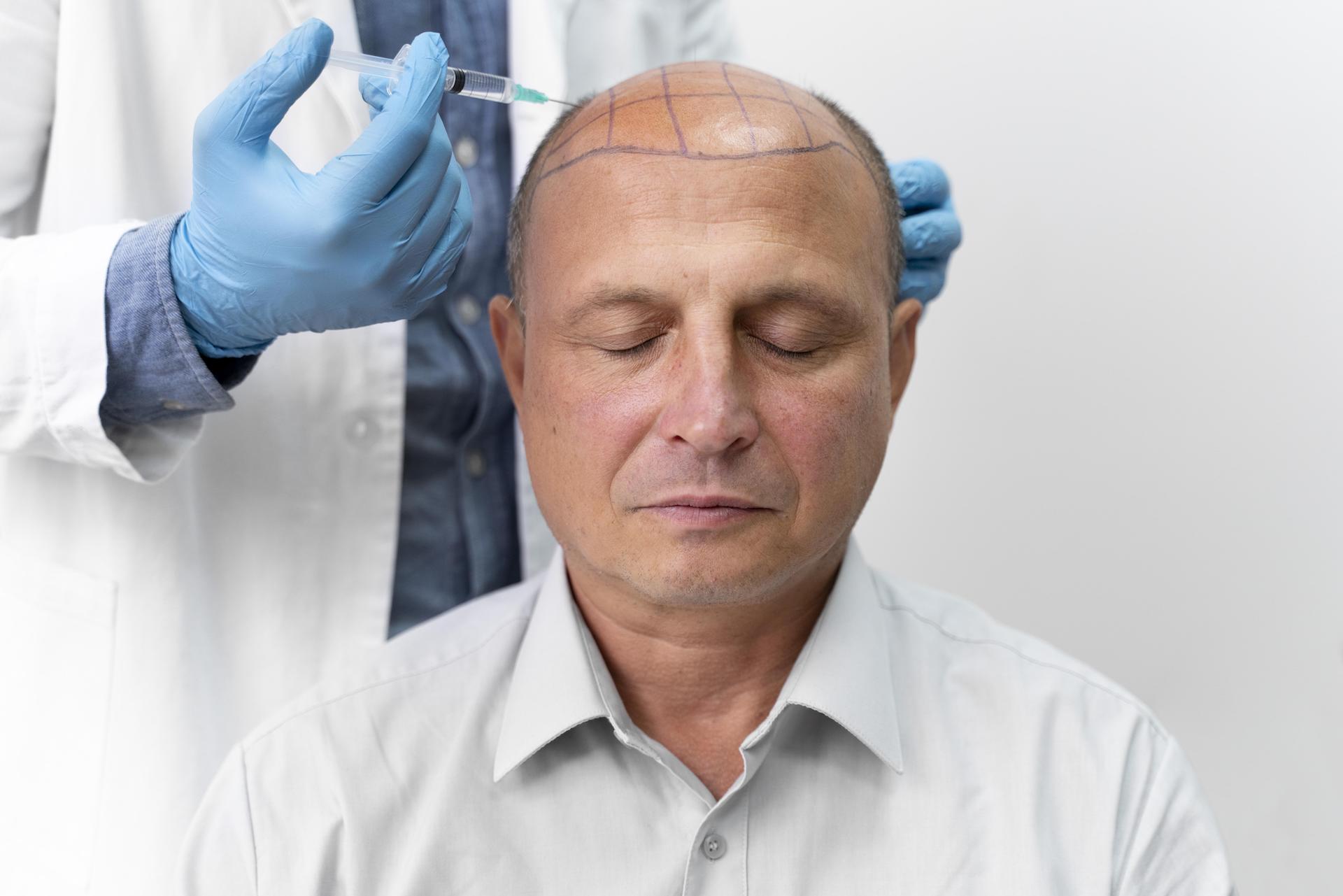
Ekim İşlemleri
Ekim işlemi donör bölgedeki greftlerin ekim için uygun olan bölgeye nakil edilmesine verilen genel isimdir. Nakil işlemi greft adı verdiğimiz kıl köklerinin bir araya gelip oluşturduğu doku bütünüdür. Ekim işlemi yapılırken, bu greftler tekli ve çoklu olarak ayrıştırılır. Ayrıştırılan greftler, uygun bölgeye nakil edilir. Dünya genelinde belirlenen %10’luk fire oranı dışında dökülme yaşanmaz.
Ekim işlemi; Saç Ekimi, Sakal ve Bıyık Ekimi, Kaş Ekimi, Favori Ekimi ve Skar Doku Ekimi olmak üzere 6 farklı alana uygulanabilir.
EKİM İŞLEMİ KİMLERE YAPILMAMALIDIR?
● Ciddi Sağlık Komplikasyonları Olan Kişilere;
Ciddi sağlık problemlerine sahip olan kişilere ekim uygulamaları yapılmamaktadır. Özellikle kişinin kalp, karaciğer ve böbrek yetmezliği gibi hastalıkları var ise bu hastalar için ekim uygulaması yapılmamaktadır. Ekim işlemini yapacak olan uzmanlar ciddi sağlık komplikasyonları olan kişiler için işlem öncesinde çeşitli testler ve muayeneler ile süreci kontrol etmektedir. Kalp ve şeker hastaları için ekim işlemi öncesinde, uzmanlar kan tahlilleri ile birlikte çeşitli tetkikler yapmak ve mutlaka hastalığın uzman doktoru tarafından onay yazısı almak zorundadırlar.
● Anesteziye Tepki Veren Kişilere;
Ekim uygulamalarında hangi teknik kullanılırsa kullanılsın genellikle lokal anestezi uygulanmaktadır. Bu tür hastalarda genel anestezi tercih edilebilir. Fakat ekim yaptıracak olan hasta genel anesteziye de tepki veriyorsa, ekim işlemi kesinlikle yapılmamaktadır. Anesteziye karşı oluşan tepki biliniyor ise uzmana bu konuda bilgi verilmelidir. Sadece anesteziye tepki veren kişiler için değil hiçbir şekilde anestezi almasına müsaade edilmeyen kişilere de ekim işlemlerinin hiçbiri uygulanmamalıdır.
● Kan Yoluyla Bulaşan Hastalığı Olan Kişilere;
Ekim işlemleri yapılacak olan kişiler içerisinde kan yoluyla bulaşan hastalığı sahip kişiler de yer almaktadır. Hepatit B hastalığına sahip olan kişilerin gerekli tedbirler alınarak ekim işlemi yapılabilir. Özellikle bu hastalık grubu içerisinde olan kişilere yapılacak olan ekim uygulamasının steril ve özel olarak düzenlenmiş bir ortam olmasına dikkat edilmelidir. Fakat HIV ve Hepatit C gibi hastalıklara sahip olan kişilere ekim uygulamaları kesinlikle yapılmamaktadır. Bunların dışında kalan ve kan yolu ile bulaşan hastalıkları taşıyan kişilere ekim uygulamalarının herhangi biri kesinlikle uygulanmamaktadır.
● Hemofili Hastalarına;
Hemofili, kanın gerektiği gibi pıhtılaşmaması sonucu kanamanın durmaması ya da geç durması ile kendini belli eden kalıtsal bir hastalıktır. Yapılan ekim işleminde, kanama olacağından işlem sonrasında greftlerin tutunmasını ve iyileşme süresini kanın pıhtılaşması sağlamaktadır. Kanın pıhtılaşmaması büyük bir faktör olduğu için, hemofili hastalarına ekim yapılmamalıdır.
● Yeteri Kadar Donörü Olmayan Kişilere;
Donör bölgesi yeterli olmayan kişilere ekim işlemi uygulanmamaktadır. Donör bölgesinde bulunan greftlerin yeteri kadar olmaması durumunda ekim uygulaması yapılmamalıdır. Ekim işleminin istenilen sonucu vermesi ve başarılı olabilmesi için, donör bölgesinin ekim yapılacak bölgeyi desteklemesi gerekmektedir.
Eğer donör bölgedeki bulunan greftler uygun kalitede veya yeteri kadar değil ise vücudun belirli diğer bölgelerinden de (sakal, göğüs, kol ve bacak) greft elde edilerek ekim işlemi yapılabilir.
Ekim Süreci Nasıl İlerler?
Ekimi yaptıracak kişinin, öncelikle uzman tarafından yapılan muayenesi sonucu eğer ekime uygun ise işlemin yapılacağı gün belirlenir. Kan tahlilleri yapılır. Planlanan tarih itibari ile hastanın uyması gereken bazı durumlar vardır.
Bu durumlar şunlardır;
- ● Alkol ya da uyuşturucu madde kullanımı varsa işlem tarihinden en az 7 gün önce ara verilmelidir.
- ● Eğer sigara içiliyorsa işlem tarihinden 7 gün öncesinde azaltılmalı, mümkünse hiç içilmemelidir.
- ● Aspirin, ginseng, B ve E vitamini gibi kan sulandırıcı etkisi olan ilaç, multivitamin ve bitkisel destekli ürün, bitki çayı çeşitleri, kiraz ve tropikal meyve gibi besinleri işlem tarihinden en az 7-10 gün öncesinde kullanılması / tüketilmesi kesinlikle bırakılmalıdır.
- ● İşlem gününden önce, herhangi bir rahatsızlık ya da kullanılan herhangi bir ilaç var ise bu konu ile ilgili uzman personele ya da hekime bilgi verilmelidir.
- ● İşlem gününden 1 gün öncesinde en az 8 saatlik uyku alınmalıdır.
- ● İşlem gününden 1 gün öncesinde ya da işlem günü sabahında kesinlikle duş alınması tavsiye edilir. Çünkü işlem yapıldıktan sonra işlem bölgesi 3 gün süresince su ile temas etmemelidir.
- ● İşlem yapılmadan önce besin değeri yüksek ürünler içeren bir kahvaltı yapılmalıdır. (Ceviz, incir, haşlanmış yumurta, tam buğday ekmeği gibi...)
● İşlem günü hava yağışlı ise şemsiye bulundurulmalıdır. Elbise ya da montunuzun kapşon kısmı kesinlikle kullanılmamalıdır.
★ Ekim İşleminden Sonra Nelere Dikkat Edilmelidir?
Ekim işlemi bittikten sonra, hastanın genel kontrolleri yapılır. Yapılan kontroller sonrasında hastanın dikkat etmesi gerekenler anlatılır;
- ● İşlemden sonraki 2 gün herhangi bir iş yapılmamalı, işe gidilmemeli ve istirahat edilmelidir. Mümkün olduğu kadar (mümkünse tüm gün) sırt üstü dinlenerek geçirilmesi, yüz bölgesinde şişlik olmasını engelleyecektir. Eğer 2 gün sonrasında şişlik oluştuysa 3-4 gün içinde geçecektir, endişe edilmemelidir. Oluşan şişliğin sağlık açısından herhangi bir zararı yoktur, sadece görüntü açısından sizi rahatsız edebilir.
- ● İşlemden sonraki 3. gün yıkama yapılması gerekir.
● Ekilen bölgedeki kabukların temizlenme süresi 7 gündür. 10 gün sonrasında ekilen greftler dökülmeye başlar ve 3. aydan sonra ekilen greftler çıkmaya başlar. Greftlerin tamamının çıkması ön bölgede 1 yıl, tepe bölgesinde 1,5 yıl kadar bir süreyi bulmaktadır.
- ● İlk 1 hafta ekim yapılan bölgeyi hiçbir yere çarpmamaya dikkat edilmelidir. Ekim yapılan bölgenin bir darbe alması ya da bir yere sürtmesi köklerin dışarı çıkmasına sebep olmaktadır. Özellikle arabaya binerken ve inerken çok dikkatli olunmalıdır.
- ● İşlemden hemen sonra eğer yolculuğa çıkılacaksa mutlaka boyundan geçmeli seyahat yastığı bulundurulmalıdır. Kafanızı kesinlikle cama ya da başka bir yere yaslayarak yolculuk etmemelisiniz. Uçak ile seyahat edecekseniz 1 gün dinlenmeniz tavsiye edilmektedir.
- ● İşlemden sonra antibiyotik ve/veya ağrı kesici ilaçlar kullanabilme ihtimali olduğundan dolayı 1 hafta süresince alkol kullanmamalısınız. İhtiyaç durumunda verilen ilaçlar tarif edildiği şekilde, düzenli olarak kullanılmalıdır.
- ● İşlemden sonraki 1 hafta süresince cinsel ilişkiye girilmemelidir.
● İşlemden sonraki 1 hafta süresince zorlanılacak, terlemeye sebep olacak ağır işler ve kardiyo, yürüyüş de dâhil olmak üzere hiçbir ağır ya da hafif spor yapılmamalıdır.
● İşlemden sonraki 1 hafta süresince önden açılır gömlek, hırka gibi kıyafetler giyilmeli, dar yakalı ya da boğazlı kıyafetler giyilmemelidir.
● Yatış pozisyonu ilk 1 hafta sırt üstü olmalıdır. Tepe bölgesine ekim yapıldı ise, ense bölgesi bir yolcu yastığı ile ya da havluyu rulo yaparak desteklenebilir ve tepe bölgesindeki ekilen saçların yastığa sürtünme riskini ortadan kaldırmalıdır.
- ● İlk yıkama işleminin polikliniğimizde uzman personel tarafından yapılması gerekmektedir.
- ● Ekimden 1 hafta sonra klinikte temizleme işlemi yapılacaktır. (Temizleme işleminin klinikte olması zorunlu değildir. Bu işlem için uzman kişiden temizleme videosunu talep edip, size tarif edildiği şekilde, bir kişinin yardımı ile evinizde de yapabilirsiniz.)
- ● Temizlemeye gelmeden önce her saat başı tekrarlamak üzere 8 saat öncesinden saatte bir olacak şekilde losyon sürülmelidir. Bu işlem sürülen bir önceki losyon temizlenmeden tekrar üzerine uygulama yapılacaktır. 8. saat sonunda son losyon uygulaması yapılıp, ekim bölgesi saç ise streç film ile sarılmalı, daha sonra klinikte temizleme işlemi gerçekleştirilmelidir.
- ● 7. günden sonra ekim bölgesi parmak uçları ile ovalayarak yıkanmalıdır.
- ● 3 ay süresince kesinlikle sauna, buhar odası, hamam ya da solaryuma girilmemelidir.
● 1 ay süresince güneş altında uzun süreli kalmamalı ya da bronzlaşma amaçlı güneşlenilmemelidir.
● 15 gün süresince yağmur, dolu gibi hava koşullarına maruz kalınmamalıdır. (Kış aylarında iseniz yanınızda sürekli şemsiye bulundurmaya özen gösterilmelidir.)
● 1 ay süresince vücut geliştirme, voleybol, basketbol vb. ağır sporlar ve 3 ay süresince savunma sporları yapılmamalıdır.
- ● 1 ay süresince futbol oynanmamalı, 3 ay süre topa kafa ile vurulmamalıdır.
● Ekim yapılan bölge 1 yıl boyunca sadece makas ile traş edilmelidir. Donör bölgesi makine ile traş edilebilir.
- ● İlk 6 ay ekim yapılan bölgeyi boyanmamalıdır.
● Kök alınan bölgede yanma, ağrı hissi azalarak 1 ile 3 haftaya kadar tamamen geçecektir.
● Saç köklerini havasız bırakacağından ve saç sağlığı açısından zararlı olacağından dolayı hiçbir zaman uzun saatler şapka takılmamalıdır.
● İşlemden sonraki 1 yıl içerisinde her 3 ayda bir kliniğe kontrole gidilmeli, gidilemiyorsa fotoğraf çekip gönderilmesi işlemin takibi için önemlidir.
● Ekim işleminden sonra karşılaşılabilecek herhangi bir problem ya da aklınıza takılan sorularla ilgili muhakkak ekim yaptırdığınız kurumun uzman personeline danışmalısınız. Yapılan işlem konusunda bilgisi olmayan bir kişi sizi yanlış yönlendirebilir, işleminizi olumsuz etkileyecek önerilerde bulunabilir.
★ EKİM İŞLEMİ AŞAMALARI ;
- Anestezi işlemi
- Donör alım işlemi
- Kanal açma işlemi
- Donör nakil (ekim işlemi)
ANESTEZİ İŞLEMİ
Öncelikle verimli greftlerin alınacağı bölge sonrasında da transferin yapılacağı alan lokal anestezi yöntemi ile uyuşturulur. Enjeksiyon ile uygulanır ve iğnenin deriye teması sırasında duyulacak acıdan başka hiçbir şey hissedilmez. Micro iğneler yardımıyla bölgenin alım işlemine hazır hale getirilmesi için yapılan uyuşturma işlemidir.
DONÖR ALMA İŞLEMİ
Genetik olarak dökülmemeye kodlanmış ve anestezi işlemi uygulanmış olan bölge, micro motorlar sayesinde kıl yapısına uygun uçlar kullanılarak tek tek belirlenir ve belirlenen greftler, pensetler yardımıyla toplanır. Donör alma işlemi uzun saça da uygulanabilir. Fakat işlem süreci ve konforu açısından daha uzun süren bir işlem olduğu için saçların tıraş edilmesi işlem süresini kısaltacağından fire oranını minimuma indirir. Dönor olarak kullanılacak olan bölge ense bölgesinde bulunan greftlerin yeterli olmaması durumunda sakaldan yada göğüsten destekle alınabilir. Toplanan greftler, hazırlanan bekleme solüsyonlarında ve uygun soğuklukta bekletilir. Greftlerin dışarıda bekleme süresi solüsyonun yapısına göre belirlenir. Bu solüsyonlar, greftin yapısını ve özelliğini bozmaz. Greftler toplandıktan sonra maksimum 4 saat içerisinde ekilmelidir.
KANAL AÇMA İŞLEMİ
Ekim işleminde, alınan donörlerin yerlerini belirlemekte (kanal açımında) geliştirilmiş ve günümüzde yaygın olarak kullanılan 4 sistem vardır. Bunlar;
- Slit : Ülkemizde ve dünyada yaygın olarak kullanılan yöntem Slit Tekniğidir. Kanalları açmak için kullanılan ince kesicilere Slit denir. Greftler, ekim yapılacak bölgedeki doku boyuna, inceliğine ve uzunluğuna göre ekim alanında açılan ince düz kesi ile hazırlanan kanallar içine ekilir. Slit tekniğindeki kesiciler, kalın kesiciler olmadığı için ekim yapılacak bölgedeki sıklık, açı ve ekim yönü rahatlıkla ayarlanabilir. Slit yönteminde kullanılan kesiciler, çeliktir. Bu kesiciler portegü ve slit tutucular ile kullanılır.
- Safir : Safir uç ile açılan kanal bir teknik değil, kanal açarken uygulanan bir inovasyondur. Uygulama aşaması ekim yapılacak bölgeye greftlerin yerleştirilmesi için küçük kesileri oluşturmayı sağlar. Fakat safir adı verilen uçlar cam benzeri kırılmaz değerli bir maddeden yapılır ve standarttır. Bu madde minimal düzeyde kabuklanma oluşumu ve daha hızlı iyileşme sağlar.
- DHI : Yapılan işleme doğrudan saç ekimi dediyebiliriz. Bu yöntem kıl yapısı ve dokusuna uygun uçlar belirledikten sonra Choi İmplanter denilen medikal kalemlerinin içine yerleştirilen kıl köklerinin kanal açmaya gerek duymaksızın ekilme işlemidir. DHI işlemi tamamen dökülmüş olan bölgeye yapıldığı gibi, dökülmenin az olduğu ya da seyrelmenin olduğu bölgeye tıraşsız olarakta yapılabilen bir işlemdir. Bu işlemde iğne uçlarına benzeyen yuvarlak uçlar kullanılır. Kullanılan kalemlerin tamamı doku uzunluğuna ve kısalığına göre içerisindeki mekanizma sayesinde rahatlıkla ayarlanabilir. İyileşme süreci kişiden kişiye değişiklik gösterebilir. Maksimum 7 gün içerisinde ekilen bölgedeki kabuklar temizlenebilir. DHI işleminde greft yapısına göre tekli greftler için farklı çoklu greftler için farklı uç kullanılması işlemin konforunu artırır ve süresini hızlandırır.
- Perkutan :Bu yöntem iğne uçlarına benzer uçlardan oluşan kanal açma yöntemidir. Perkutan yönteminde kullanılan donör bölge, saçtan sakaldan yada göğüsten alınan kıl köklerinden tercih edilebilir. Ekim yapılacak olan işlem bölgesi saç, sakal, bıyık yada kaş bölgesi olabilir. Perkutan yönteminde kanallar safir veya slit yöntemindeki gibi kesiler şeklinde değil daha çok DHI yönteminde kullanılan uçlar gibi yuvarlak şeklindedir.
Bölgenin saçlı yada saçsız olması yapılan işlemin kalitesini etkilemez fakat kanalların ve saçların daha sıkı olmasını sağlamak için ekim bölgesi traş edilmelidir.



